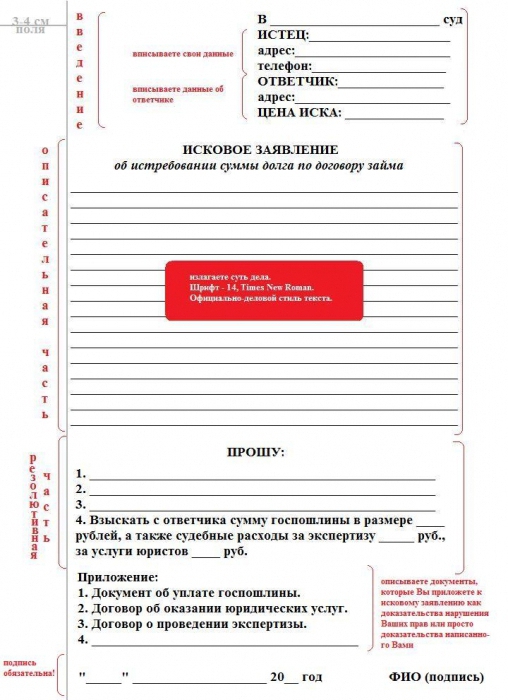In modern society, intelligent people prefer to resolve disputes and conflicts that have arisen between them in the legal framework, applying for this with a statement to the court.
It should be noted that any trial is a very complex and sometimes lengthy procedure. Each legal case is based on a statement of claim, the competent preparation of which is the most important prerequisite for a successful resolution of the conflict.
However, apart from the question of how make a statement of claim to the court, Typically, future plaintiffs are interested in where to turn to receive a sample statement of claim, what you need to know about the state duty when filing a lawsuit, whether they can refuse to accept the lawsuit, and so on. Having received answers to these questions, each citizen can independently, without spending fabulous money on the services of lawyers, defend their interests and legally restore violated rights.

What is a statement of claim?
Before applying to the court, you must clearly understand what a statement of claim is.
A statement of claim is a written appeal to a court filed by an individual or legal entity that claims that its rights were violated by someone. By filing a lawsuit in court, the plaintiff hopes that by a court decision his violated rights will be restored, and in certain cases he can count on receiving compensation.
Parties to the court: plaintiff and defendant
The plaintiff is the person who filed a lawsuit in court. The defendant is the person to whom the plaintiff presents his claim.
At first glance, everything seems extremely clear. Suppose, some time ago, you loaned a certain amount of money to your friend and took a receipt from him. However, when the time has come to repay the debt, the borrower refuses to do so. Naturally, to restore justice, you decide to sue. In this case, you are the plaintiff, and your friend is the defendant.
Or, for example, two years ago you had an accident. Your vehicle has been disposed of as it could not be repaired. At the same time, the tax inspectorate continues to send notifications to your home address about the need to pay a tax on your personal property, which has long been gone. After long trials and explanations with tax inspectors, you go to court. In this case, you are the plaintiff, and the tax office is the defendant.

With these examples, everything is clear, no problems should arise. However, imagine a situation when, having dined in one of the restaurants, a person ate poor-quality food, was poisoned, and subsequently died. It is clear that the restaurant will be the defendant in court. And then who will be the plaintiff?
Which court should file a lawsuit?
Before you make a statement of claim, you must decide which court you need to appeal to. Depending on the area in which the dispute arose, as well as on the composition of the parties, the lawsuit is filed with different courts of competence. In the Russian Federation there are two main judicial systems:
- court of general jurisprudence;
- court of Arbitration.
A statement of claim is filed with the arbitration court if disputes arise between legal entities (for example, organizations) or between organizations and the state. In addition, the arbitration court considers issues of declaring companies bankrupt.
The courts of general jurisprudence consider all other cases, including criminal ones.

So, the rule is quite simple: if you are an individual and want to get something from an individual as well, then you probably need to file a lawsuit in a court of general jurisprudence. However, if you are an organization and you have disputes with any other organization or government agency, then you need to appeal to arbitration.
Further, it all depends on the type of requirements and their size. Thus, if the plaintiff expects to receive material compensation from the plaintiff, not exceeding the amount of 50 thousand rubles, it will be necessary to file a lawsuit in a magistrate court. This case will be considered by the justice of the peace. However, if the amount of the claim filed is more than 50 thousand rubles, you should write a statement of claim to the district court.
Subject of the statement of claim and its basis
Before writing a lawsuit, it is required to clarify two important things: what is the subject of the lawsuit and what is its basis.
Speaking about the subject of the claim, the plaintiff's claims to the defendant are assumed, that is, what he wants to receive. In order not to be in an awkward position and not look ridiculous, look at a sample of the statement of claim in court and, based on its example, make your own claim.
As for the grounds for the claim, these are the factual circumstances that entail legal consequences, and which the plaintiff relies on when filing a lawsuit. For example, a neighbor has borrowed money from you and refuses to give it back. This is an actual fact.
Documentary substantiation of the statement of claim
It is very important that the statement of claim be supported by evidence. Witness testimony is not the best option, because in our country judges are very skeptical of witness testimony. Therefore, ideally, it would be nice to scrupulously store all receipts for purchases, receipts, when making transactions, require the original documents, not copies thereof, etc. By securing yourself in time, you will be able to protect yourself from many unexpected problems in the future, and you will be sure of success if a lawsuit awaits you.
How to avoid mistakes when making a statement of claim?
After weighing the pros and cons and still making the decision to file a lawsuit, most people ask themselves a reasonable question about how to file a lawsuit. Of course, the easiest way is to pay a lawyer who will do everything for you. However, if this is not possible, it is quite possible to make a statement yourself. To do this, first of all, you will need a sample statement of claim to the court. After that, you can proceed directly to filling out the application.

Each claim must contain the following information without fail:
• name of the court;
• the word “Statement” or “Complaint” is written in the middle of the sheet (as the case may be);
• information about who is filing the lawsuit, that is, about the plaintiff (for a citizen - full name, place of permanent registration; for a legal entity - the name of the organization, legal address, postal code, as well as bank details);
• information about the defendant (the same as for the plaintiff);
• claims to which relevant evidence is attached;
• if the plaintiff plans to receive material compensation from the defendant, the amount of the required compensation should be indicated in the claim;
• appendices to the statement of claim (describe in detail each document that is attached to the claim);
• signature of the plaintiff.
State duty of a lawsuit
Remember that if you have not paid the state fee, the application may be refused to be considered. “Calculators of state fees to court” are many. However, in order to avoid misunderstandings, it is better to clarify the information in the registry of the court.
The state duty is paid at Sberbank. For citizens, a receipt issued by Sberbank is proof of payment of the state duty.As for legal entities, after payment of the state fee they are issued a payment with the corresponding mark of the operator, as well as an extract confirming that the money has arrived in the state budget.
After performing these simple steps, you can file a lawsuit in court without worrying that it will be rejected due to non-payment of state duty.
What should be considered when filing a statement of claim?
Filing a lawsuit involves 2 ways: a claim can be filed in person or sent by mail.
When applying directly to the court, your personal presence is required. You should ask the bailiff or any other employee of the court which office you need to go to, go to the office, ask for a sample of the statement of claim to the court, check it with yours and, if no errors are found, file a lawsuit.
It should be prepared for the fact that some unscrupulous employees, using the legal illiteracy of citizens, may unreasonably refuse to accept and register a claim. Remember that this is an unlawful act and violates your civil rights.
When submitting an application by mail, the application itself and the documents attached to it must be enclosed in the envelope. Everything is sent by registered mail. As soon as the letter arrives at the clerk of the court, within five days the judge must consider the application, accept or reject it and notify the plaintiff of the result.
Can they refuse to register and accept a statement of claim?
Refuse to accept the claim can only be the judge, to whom the application gets after registration in the office. The grounds for refusal are prescribed in Articles 134-136 of the Code of Civil Procedure. So, the judge will not accept the application if:
• the pre-trial settlement procedure was violated;
• the case does not fall under the jurisdiction of this court (for example, you filed a lawsuit in an arbitration court, but you had to go to a court of general jurisprudence);
• the plaintiff was declared legally incompetent;
• the claim was filed and signed by a person who does not have authority to do so;
• in this court or in another case is already pending in the dispute;
• the plaintiff received a statement stating that he refuses the claim submitted by him.
In case of refusal, the judge must motivate his decision. The determination shall indicate the essence of the statement of claim and the reasons why the statement was rejected. Subsequently, having eliminated the reason for which the claim was refused, the plaintiff may re-file the claim. In addition, if the plaintiff does not agree with the justification for refusing to accept his application, he can exercise the right to file a private complaint.
Judicial sitting
So, you figured out how to make a statement of claim in court, a date was set preliminary hearing. What's next? Very simple: come to court on the appointed date and time.
When you arrive, ask if your case will be heard. After the preliminary hearing, after hearing both parties (the plaintiff and the defendant), the judge will schedule a hearing, which takes place approximately as follows:
• the judge identifies the plaintiff and the defendant, reads out the rights and obligations of the parties in court, asks the parties if they have any motions;
• followed by the statement of the plaintiff;
• after the plaintiff, the defendant is heard;
• the judge asks the parties whether they have a desire to make peace before a decision is made;
• plaintiff and defendant express their opinions on this matter;
• the judge examines the evidence and retires to make a decision;
• in conclusion, the judge reads out the decision made by him.
Judgment and enforcement
At the end of the session, the judge makes a decision. Further, the plaintiff and the defendant receive a court decision and the so-called writ of execution. The court decision contains information about who appealed to the court, the grounds and requirements of the plaintiff, who acted as the defendant, what evidence was presented and what conclusion the judge came to. Such information is absent in the writ of execution.It describes the actions that must be performed by the defendant. The writ of execution must be submitted to the bailiff service.

That's all. You learned how to make a statement of claim to the court, went around all the necessary instances, and beat the thresholds of numerous offices. The whole complicated litigation is behind.
Download the claim form to the court








